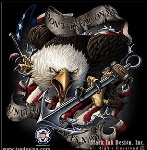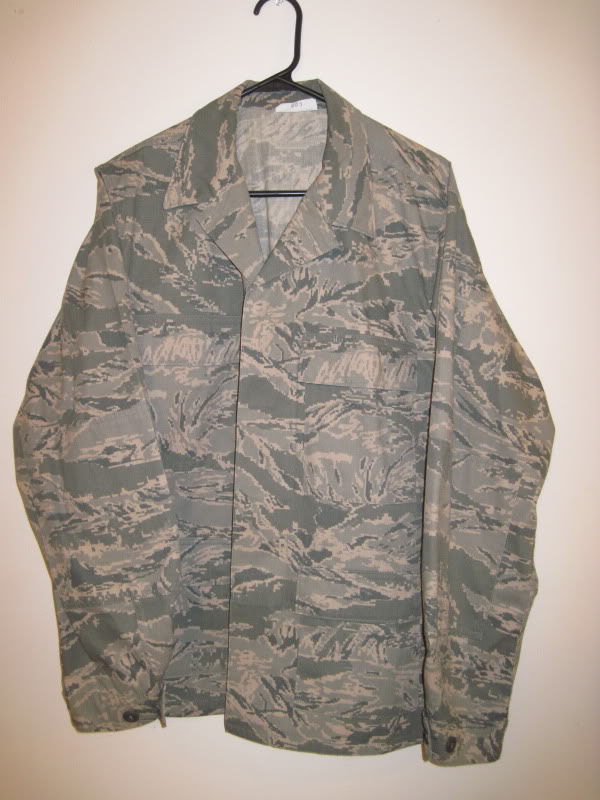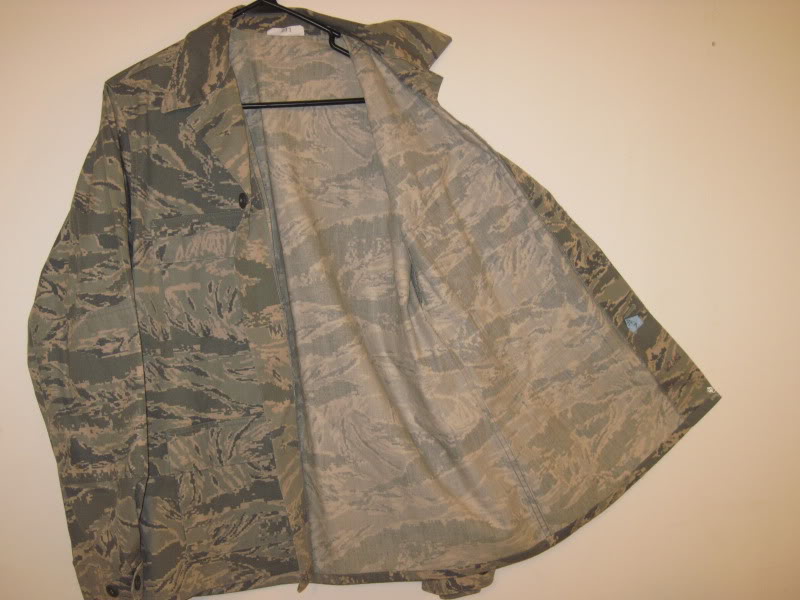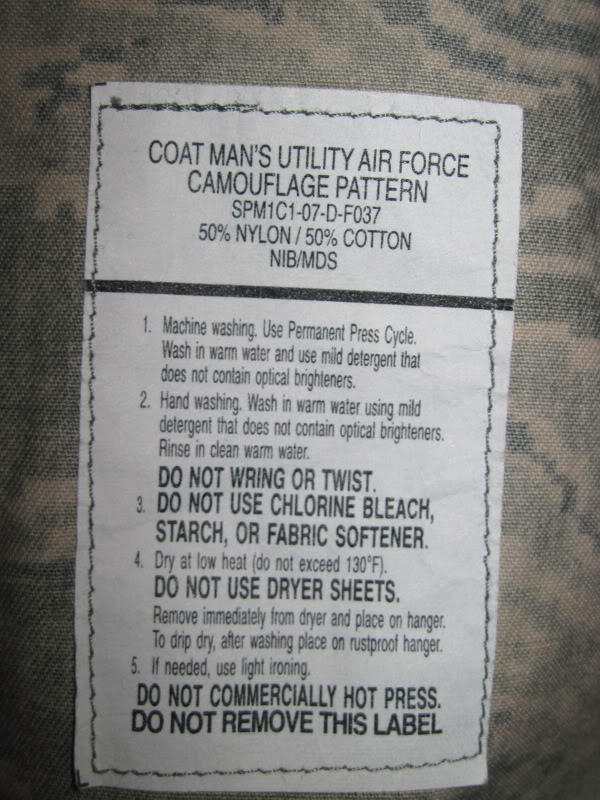+5
CollectinSteve
panzerwerk
misanthropic_gods
Philip
navax
9 posters
Another ABU thread.... well somewhat different

navax- Junior Sergeant

- Name : Jake
Age : 31
Location : florida
Registration date : 2010-04-13
Number of posts : 154
So how many of the people on here own an ABU? I own a Staff Sergeant's jacket that has the map pockets and is really really heavy. I'm wondering how everyone here feels about it. Also, where was your jacket made? I thought it was interesting that my jacket was made in the Dominican Republic.

Philip- ADMIN MODERATOR

- Location : Austria
Registration date : 2009-02-17
Number of posts : 3120
If your shirt is made in the Dominican Republic then it's a privately purchased commercial item.
_________________
http://philipscamocollection.npage.at/
https://www.instagram.com/philipscamocollection/

misanthropic_gods- MODERATOR

- Location : Illinois, USA
Registration date : 2009-07-27
Number of posts : 991
If I remember correctly, Propper's Civilian stuff (even if it is identical to issue stuff, even down to being NIR Compliant) is made in the Dominican Republic. A requirement for .gov contracts is that it is made in the US, so their contract stuff is made here. Tons of guys private purchase Propper stuff though, so its not uncommon at all to see them.
I will post my ABU shirt here sometime in the next few days
I will post my ABU shirt here sometime in the next few days

panzerwerk- Colonel

- Name : Steve Hoeger
Age : 56
Location : California , U.S.A
Registration date : 2009-02-16
Number of posts : 3068
I have 2 shirts , first pattern with internal pockets and a 2nd or 3rd model , both made in USA .
First version

2nd or 3rd version

First version

2nd or 3rd version


CollectinSteve- ADMIN

- Location : New England, US
Registration date : 2009-03-08
Number of posts : 6952
Yup, as others have said... if it is genuine issue it's made in the US. If it is not made in the US it isn't genuine issue, even though practically speaking the differences are often close to zero.
As a recap:
1st Model - thick cotton/poly mix, internal pockets. Hated by service members, especially those in combat theaters. Internal pockets were often cut out to improve breathability.
2nd Model - nearly the same as above but without the internal pockets. Still hated because the cloth simply does not breath.
3rd Model - lighter weight fabric and a large number of very minor changes, such as repositioning the arm pen pocket so the pens didn't break due to arm flexing. That sort of thing.
Trousers are apparently the same as they were from the beginning.
Steve
As a recap:
1st Model - thick cotton/poly mix, internal pockets. Hated by service members, especially those in combat theaters. Internal pockets were often cut out to improve breathability.
2nd Model - nearly the same as above but without the internal pockets. Still hated because the cloth simply does not breath.
3rd Model - lighter weight fabric and a large number of very minor changes, such as repositioning the arm pen pocket so the pens didn't break due to arm flexing. That sort of thing.
Trousers are apparently the same as they were from the beginning.
Steve

navax- Junior Sergeant

- Name : Jake
Age : 31
Location : florida
Registration date : 2010-04-13
Number of posts : 154
Well I just read something that the jackets are also used by the Dominican Air Force. Also, my jacket has the NSN number on the tag and I know it was the first version

Philip- ADMIN MODERATOR

- Location : Austria
Registration date : 2009-02-17
Number of posts : 3120
A lot of commercial stuff have stock numbers. Propper, Tru-Spec,...
_________________
http://philipscamocollection.npage.at/
https://www.instagram.com/philipscamocollection/

navax- Junior Sergeant

- Name : Jake
Age : 31
Location : florida
Registration date : 2010-04-13
Number of posts : 154
Yeah mine is a commercial made Propper.

panzerwerk- Colonel

- Name : Steve Hoeger
Age : 56
Location : California , U.S.A
Registration date : 2009-02-16
Number of posts : 3068
Yeah mine is a commercial made Propper
If its badged with name tape , it was most likely a private purchase item , so it was used and is right as rain , it was just not an issue piece , so its real !

navax- Junior Sergeant

- Name : Jake
Age : 31
Location : florida
Registration date : 2010-04-13
Number of posts : 154
panzerwerk wrote:Yeah mine is a commercial made Propper
If its badged with name tape , it was most likely a private purchase item , so it was used and is right as rain , it was just not an issue piece , so its real !
Yea, the person took their name tape off the uniform before turning it in.
So I have a question since we're on this topic. Why do people private purchase items? I mean I've seen the prices compared to GI items at places like PX and NEX and it's a HUGE difference.

panzerwerk- Colonel

- Name : Steve Hoeger
Age : 56
Location : California , U.S.A
Registration date : 2009-02-16
Number of posts : 3068
for some of my friends who are serving , they buy it because its not available to them from official channels , it may be hard to believe , but if you are about to deploy and your not issued the right stuff , you go buy it , and sometimes commercial items are on the market before the military starts handing it out in numbers , the first Gulf war showed this with all the 3 color stuff , much in the beginning was private purchased .

navax- Junior Sergeant

- Name : Jake
Age : 31
Location : florida
Registration date : 2010-04-13
Number of posts : 154
It makes perfect sense now. Thanks 

CollectinSteve- ADMIN

- Location : New England, US
Registration date : 2009-03-08
Number of posts : 6952
Yeah, the NSN number means very little. It's the SPA number that matters. Commercial pieces can have NSN, but not SPA.
Steve is right. The primary reason for a private purchase is the gov't issue stuff is unavailable to the particular soldier. The ACUs came out VERY slowly in official channels, very quickly in places like US Cavalry. Soldiers who just couldn't wait to get their new ACUs (hard to believe, I know it ) could get their hands on a Propper commercial version in a couple of days right in the mail. The problem of soldiers purchasing outside of the system was so great that the Army had to remind soldiers, quite forcefully, that it was an offense to do so. 25th Infantry Division even had the warning posted to their homepage!
) could get their hands on a Propper commercial version in a couple of days right in the mail. The problem of soldiers purchasing outside of the system was so great that the Army had to remind soldiers, quite forcefully, that it was an offense to do so. 25th Infantry Division even had the warning posted to their homepage!
The other thing that can happen is when a soldier is stationed outside of his normal base environment. For example, at a training school that doesn't have a PX for their branch of service (like Ft. Sill). I knew a Marine Major that had to buy his own body armor even before going to Fallujah! He was flying out directly from some oddball posting to Kuwait and was told he had to go into theater kitted out. But nobody could get the kit to him in time, so he bought it out of his own pocket money (I assume he got reimbursed later).
Steve
Steve is right. The primary reason for a private purchase is the gov't issue stuff is unavailable to the particular soldier. The ACUs came out VERY slowly in official channels, very quickly in places like US Cavalry. Soldiers who just couldn't wait to get their new ACUs (hard to believe, I know it
The other thing that can happen is when a soldier is stationed outside of his normal base environment. For example, at a training school that doesn't have a PX for their branch of service (like Ft. Sill). I knew a Marine Major that had to buy his own body armor even before going to Fallujah! He was flying out directly from some oddball posting to Kuwait and was told he had to go into theater kitted out. But nobody could get the kit to him in time, so he bought it out of his own pocket money (I assume he got reimbursed later).
Steve

misanthropic_gods- MODERATOR

- Location : Illinois, USA
Registration date : 2009-07-27
Number of posts : 991
I think mine is a very early (07 Dated) 2nd Pattern ABU, I got it cheap ($11) on ebay

Lack of Map Pockets



Lack of Map Pockets



navax- Junior Sergeant

- Name : Jake
Age : 31
Location : florida
Registration date : 2010-04-13
Number of posts : 154
CollectinSteve wrote:Yeah, the NSN number means very little. It's the SPA number that matters. Commercial pieces can have NSN, but not SPA.
Steve is right. The primary reason for a private purchase is the gov't issue stuff is unavailable to the particular soldier. The ACUs came out VERY slowly in official channels, very quickly in places like US Cavalry. Soldiers who just couldn't wait to get their new ACUs (hard to believe, I know it) could get their hands on a Propper commercial version in a couple of days right in the mail. The problem of soldiers purchasing outside of the system was so great that the Army had to remind soldiers, quite forcefully, that it was an offense to do so. 25th Infantry Division even had the warning posted to their homepage!
The other thing that can happen is when a soldier is stationed outside of his normal base environment. For example, at a training school that doesn't have a PX for their branch of service (like Ft. Sill). I knew a Marine Major that had to buy his own body armor even before going to Fallujah! He was flying out directly from some oddball posting to Kuwait and was told he had to go into theater kitted out. But nobody could get the kit to him in time, so he bought it out of his own pocket money (I assume he got reimbursed later).
Steve
So let me get this straight. Uniforms can go in very slow channels through the military, so guys buy commercial. While, the military reminds them that it is an offense to buy commercial products. Is that sound about right?

panzerwerk- Colonel

- Name : Steve Hoeger
Age : 56
Location : California , U.S.A
Registration date : 2009-02-16
Number of posts : 3068
In a nut shell , yes ....... the guys have acronym for it, SNAFU . Situation normal all f***ed up.

navax- Junior Sergeant

- Name : Jake
Age : 31
Location : florida
Registration date : 2010-04-13
Number of posts : 154
panzerwerk wrote:In a nut shell , yes ....... the guys have acronym for it, SNAFU . Situation normal all f***ed up.
Haha you gotta love the military. I've heard so many things that go kinda like this except in a Navy manual.

CollectinSteve- ADMIN

- Location : New England, US
Registration date : 2009-03-08
Number of posts : 6952
Yup!
There was a lot of private purchasing during Desert Shield because the Army hadn't adequately stockpiled uniforms for a large scale desert engagement. However, local surplus shops had enough stuff to outfit two armies
BTW, I said SPA number. Typo. I should have written SPM. As far as I know SPM is the only correct prefix for Army, Airforce, and Navy clothing/textile items. There is also SPE, which I think is for equipment.
Steve
There was a lot of private purchasing during Desert Shield because the Army hadn't adequately stockpiled uniforms for a large scale desert engagement. However, local surplus shops had enough stuff to outfit two armies
BTW, I said SPA number. Typo. I should have written SPM. As far as I know SPM is the only correct prefix for Army, Airforce, and Navy clothing/textile items. There is also SPE, which I think is for equipment.
Steve

Philip- ADMIN MODERATOR

- Location : Austria
Registration date : 2009-02-17
Number of posts : 3120
Don't you mean SPO?
_________________
http://philipscamocollection.npage.at/
https://www.instagram.com/philipscamocollection/

navax- Junior Sergeant

- Name : Jake
Age : 31
Location : florida
Registration date : 2010-04-13
Number of posts : 154
I'm sure glad I posted this. I've learned so much about private purchase items and the ABU. Another question, is it possible to determine what year an item was made?
Thanks
Jake
Thanks
Jake

nkomo- ADMIN

- Name : Arch
Location : Kentucky, USA
Registration date : 2009-02-13
Number of posts : 3324
Steven is 100% correct about commercial vs. issue. Lots of soldier went into OIF with commercial items. I remember our local news station doing several segments where local people were having to buy their sons and duaghters body armor because the Army didn't have enough to go around. As a matter of fact, they started a fund raising campaign to help defray the costs being shouldered by these familes.CollectinSteve wrote:
The other thing that can happen is when a soldier is stationed outside of his normal base environment. For example, at a training school that doesn't have a PX for their branch of service (like Ft. Sill). I knew a Marine Major that had to buy his own body armor even before going to Fallujah! He was flying out directly from some oddball posting to Kuwait and was told he had to go into theater kitted out. But nobody could get the kit to him in time, so he bought it out of his own pocket money (I assume he got reimbursed later).
Steve
_________________
Always looking for Central American militaria 1965 to 1991. Especially items relating to Coronel Velasquez El Salvador Armed Forces

navax- Junior Sergeant

- Name : Jake
Age : 31
Location : florida
Registration date : 2010-04-13
Number of posts : 154
nkomo wrote:Steven is 100% correct about commercial vs. issue. Lots of soldier went into OIF with commercial items. I remember our local news station doing several segments where local people were having to buy their sons and duaghters body armor because the Army didn't have enough to go around. As a matter of fact, they started a fund raising campaign to help defray the costs being shouldered by these familes.CollectinSteve wrote:
The other thing that can happen is when a soldier is stationed outside of his normal base environment. For example, at a training school that doesn't have a PX for their branch of service (like Ft. Sill). I knew a Marine Major that had to buy his own body armor even before going to Fallujah! He was flying out directly from some oddball posting to Kuwait and was told he had to go into theater kitted out. But nobody could get the kit to him in time, so he bought it out of his own pocket money (I assume he got reimbursed later).
Steve
Jeez, you would think the logistics or supply personnel would have done a better job as far as ordering these items goes. But I guess I'm wrong since it would depend on the manufacture's.

CollectinSteve- ADMIN

- Location : New England, US
Registration date : 2009-03-08
Number of posts : 6952
The primary problem is how much do you keep in stock for what sort of engagement. When Desert Shield kicked off it was the single largest deployment of US forces since the early 1970s. If equipment needs never changed, if technology never improved, then you could stockpile enough gear for the worst case scenario and never have to worry about it being outdated. From a logistics standpoint, unfortunately, reality is different.
One criticism of OIF is that there was plenty of time to procure the correct amounts of equipment necessary for the force that actually attacked into Iraq. But there were two problems with that:
1. The initial buildup of forces was being done "under the radar" of Congress for the first few months. If everything had been done in the open, and competently, Congress could have authorized the funds necessary for the additional materials in time for the decisions to have had some impact on readiness levels. But since they weren't asked for such authorizations until after the invasion that opportunity was lost.
2. The initial size of the invasion force was about 60% smaller than the actual force that entered Iraq, which itself was about 20% smaller than the eventual size of the force after the insurgency gained ground. And of course this was about 30-50% lower than the head of the Army recommended. The point here is that the leadership underestimated the force size and therefore it isn't surprising that they underestimated the needs of a larger force. Had the initial plan been more realistic in its needs from the outset, it is logical that the supply problems would have been less serious than they were.
Some people may take the above comments to be politically partisan. I can assure you they are not intended to be taken that way. It's just an assessment of how sub-optimal planing produces sub-optimal results. Since there's hardly anybody that would say that the planning for OIF was as good as it could have been, not to mention should have been, it's not surprising that there were noticeable deficiencies in critical areas.
Steve
One criticism of OIF is that there was plenty of time to procure the correct amounts of equipment necessary for the force that actually attacked into Iraq. But there were two problems with that:
1. The initial buildup of forces was being done "under the radar" of Congress for the first few months. If everything had been done in the open, and competently, Congress could have authorized the funds necessary for the additional materials in time for the decisions to have had some impact on readiness levels. But since they weren't asked for such authorizations until after the invasion that opportunity was lost.
2. The initial size of the invasion force was about 60% smaller than the actual force that entered Iraq, which itself was about 20% smaller than the eventual size of the force after the insurgency gained ground. And of course this was about 30-50% lower than the head of the Army recommended. The point here is that the leadership underestimated the force size and therefore it isn't surprising that they underestimated the needs of a larger force. Had the initial plan been more realistic in its needs from the outset, it is logical that the supply problems would have been less serious than they were.
Some people may take the above comments to be politically partisan. I can assure you they are not intended to be taken that way. It's just an assessment of how sub-optimal planing produces sub-optimal results. Since there's hardly anybody that would say that the planning for OIF was as good as it could have been, not to mention should have been, it's not surprising that there were noticeable deficiencies in critical areas.
Steve

navax- Junior Sergeant

- Name : Jake
Age : 31
Location : florida
Registration date : 2010-04-13
Number of posts : 154
CollectinSteve wrote:The primary problem is how much do you keep in stock for what sort of engagement. When Desert Shield kicked off it was the single largest deployment of US forces since the early 1970s. If equipment needs never changed, if technology never improved, then you could stockpile enough gear for the worst case scenario and never have to worry about it being outdated. From a logistics standpoint, unfortunately, reality is different.
One criticism of OIF is that there was plenty of time to procure the correct amounts of equipment necessary for the force that actually attacked into Iraq. But there were two problems with that:
1. The initial buildup of forces was being done "under the radar" of Congress for the first few months. If everything had been done in the open, and competently, Congress could have authorized the funds necessary for the additional materials in time for the decisions to have had some impact on readiness levels. But since they weren't asked for such authorizations until after the invasion that opportunity was lost.
2. The initial size of the invasion force was about 60% smaller than the actual force that entered Iraq, which itself was about 20% smaller than the eventual size of the force after the insurgency gained ground. And of course this was about 30-50% lower than the head of the Army recommended. The point here is that the leadership underestimated the force size and therefore it isn't surprising that they underestimated the needs of a larger force. Had the initial plan been more realistic in its needs from the outset, it is logical that the supply problems would have been less serious than they were.
Some people may take the above comments to be politically partisan. I can assure you they are not intended to be taken that way. It's just an assessment of how sub-optimal planing produces sub-optimal results. Since there's hardly anybody that would say that the planning for OIF was as good as it could have been, not to mention should have been, it's not surprising that there were noticeable deficiencies in critical areas.
Steve
Makes sense. But didn't the ABU and the other patterns come out recently? Wouldn't of that given USAF enough time to produce large amounts?
Jake

panzerwerk- Colonel

- Name : Steve Hoeger
Age : 56
Location : California , U.S.A
Registration date : 2009-02-16
Number of posts : 3068
I have a friend who is Security personnel in the Air Force , I asked him to get me a set of ABU's when the commercial stuff was hitting the market as I wanted the real deal , he was still wearing Woodland and DCU's on his deployments , they had not gotten the ABU's by then , but you could buy them commercially .
Its not a very uncommon thing .
Its not a very uncommon thing .
|
|
|


 by navax Thu Apr 15, 2010 10:24 pm
by navax Thu Apr 15, 2010 10:24 pm